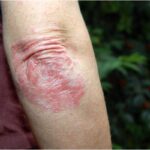Everyone thinks they know what an alcoholic looks like, thanks to their characterization in the media. You may see that they stumble along, and they’re flushed.
But the most flushed of all is the bumpy red nose. A drinker’s nose goes by many names, including whiskey nose.

It’s normal for your face to feel flushed after a night of drinking, but a drinker’s nose doesn’t appear the same way. A drinker’s nose is referred to as rhinophyma, a significant symptom of rosacea.
When it comes to this skin condition, it’s not because of alcoholism that it occurs, but it is one factor that can cause this.
What Does A Drinker’s Nose Look Like?
Previously, I mentioned how a drinker’s nose causes a red bumpy appearance. In most cases, the drinker’s nose is red and bumpy, swollen around the cheeks or directly on the nose.
Depending on the severity, it may even appear more purple if a significant amount of alcohol causes it.
When your nose takes on this appearance, it is called rhinophyma, a skin condition you can get from drinking alcohol. However, that isn’t the only cause of it.
What Is Rhinophyma?
Rhinophyma is a skin condition that is a symptom of rosacea. Many people have associated this condition with alcoholism, but no direct links confirm this. While drinking may exacerbate the symptoms, it is not directly caused by alcoholism.
To better understand rhinophyma, it’s best to understand what rosacea is. Rosacea is a common skin condition that causes redness and makes blood vessels visible on the face.
It’s overall more commonly developed by women who are diagnosed between the ages of 30 and 50. While rosacea is more commonly developed in women, men are at a higher risk of rhinophyma.
While you may think you can avoid a drinker’s nose by not drinking alcohol, rhinophyma can also occur when you don’t drink.
Why Does Drinking Cause Drinker’s Nose?
Getting a flushed appearance after drinking is normal, but if you drink too much, your nose will retain its red coloring. This is due to how alcohol affects blood vessels once it’s in the bloodstream.
Depending on how much alcohol you drink, your blood vessels will either expand or constrict, which will cause a red appearance.
While you may think having a red nose will be a tell-tale sign of alcoholism, this isn’t the case. There are many arguments regarding how drinking frequently affects rhinophyma.
There are conflicting studies, but overall, it’s agreed that drinking can be a trigger of rhinophyma.
How Can You Reduce The Symptoms Of Rhinophyma?
Some methods can help reduce your symptoms and clear your skin if you don’t have severe rhinophyma. The best way to reduce your symptoms is by avoiding certain triggers that have had a significant impact on how your rhinophyma has been growing.
In some cases, if you believe your rhinophyma is caused by alcohol, then the best way is to cut back. However, this may be more difficult for you if you’re struggling with alcohol addiction.
You can also avoid other triggers if you don’t have an alcohol addiction. These include direct exposure to sunlight and avoidance of caffeine and spicy foods.
Avoiding stressful situations can also help you treat your rhinophyma, avoiding extreme temperatures, regardless of whether they are hot or cold.
Changing your diet to avoid caffeine and spicy foods may help you a lot, but if you work outside, it may be more of a challenge for you to avoid extreme temperatures or direct exposure to sunlight.
However, if you believe that your rhinophyma is being caused by alcohol addiction (see also ‘Best Alcohol Addiction Treatment Centers In America‘), you may believe it is best to look for a nearby alcohol addiction program.

Recovery For Alcohol Addiction
If you are struggling with alcohol addiction, it’s best to contact a professional to get the help that you need.
Recovering from addiction is a long and difficult process, but it can be made easier with the help of professional help from healthcare and mental health professionals.
With professional help, you should be able to successfully give up your alcohol addiction (see also ‘How To Support Someone Recovering From Addiction‘).
Surgical Treatment For Rhinophyma
Depending on how severe your rhinophyma is, you may be able to get surgery to treat and reshape your nose. If tissue on your nose has grown or your blood vessels have grown too large, you may be eligible for treatment.
Upon getting help, you may find that you can breathe easier and feel more comfortable in your appearance.
If you’re getting treatment for cosmetic reasons, you may have laser treatment to reshape the surface of your nose. Or a surgeon will use dermabrasion, using a small rotating device to remove the top layers of skin on your nose.
This will remove the bulk of tissue from your nose and help return it to its original shape.
In severe cases, the bulk of the tissue on your nose will be removed with a sharp instrument or surgical cautery and will monitor the healing process with dressing changes.
In rare cases, they will use skin grafting to treat your rhinophyma. These treatments will only occur in severe situations and are not the first treatment option if you require it.
Final Thoughts
If you’re struggling with alcohol addiction, it is best to get help so you can continue to have a higher standard of living. However, remember that a drinker’s nose is not only caused by alcohol addiction.
Some have rhinophyma but never have drunk alcohol in their lives.
If you believe you’re struggling with rhinophyma, you should contact your doctor to discuss treatment options. They can suggest different creams to help treat this condition and help alleviate symptoms.
You can also avoid triggers to help prevent your rhinophyma from worsening.
While a drinker’s nose does exist, it is not only caused by alcoholism. If you see someone struggling with rhinophyma, it’s best not to assume they have an alcohol addiction, as there are multiple triggers to this skin condition.
While drinking can change the coloring of your nose and give you a flushed appearance, a drinker’s nose is not something that occurs to everyone.
- Understanding Male Reproductive Health: A Complete Guide - February 2, 2025
- Simple Healthy Skin Habits for Radiant Skin - December 6, 2024
- Unlocking the Connection Between Nutrition and Mental Health - December 3, 2024








